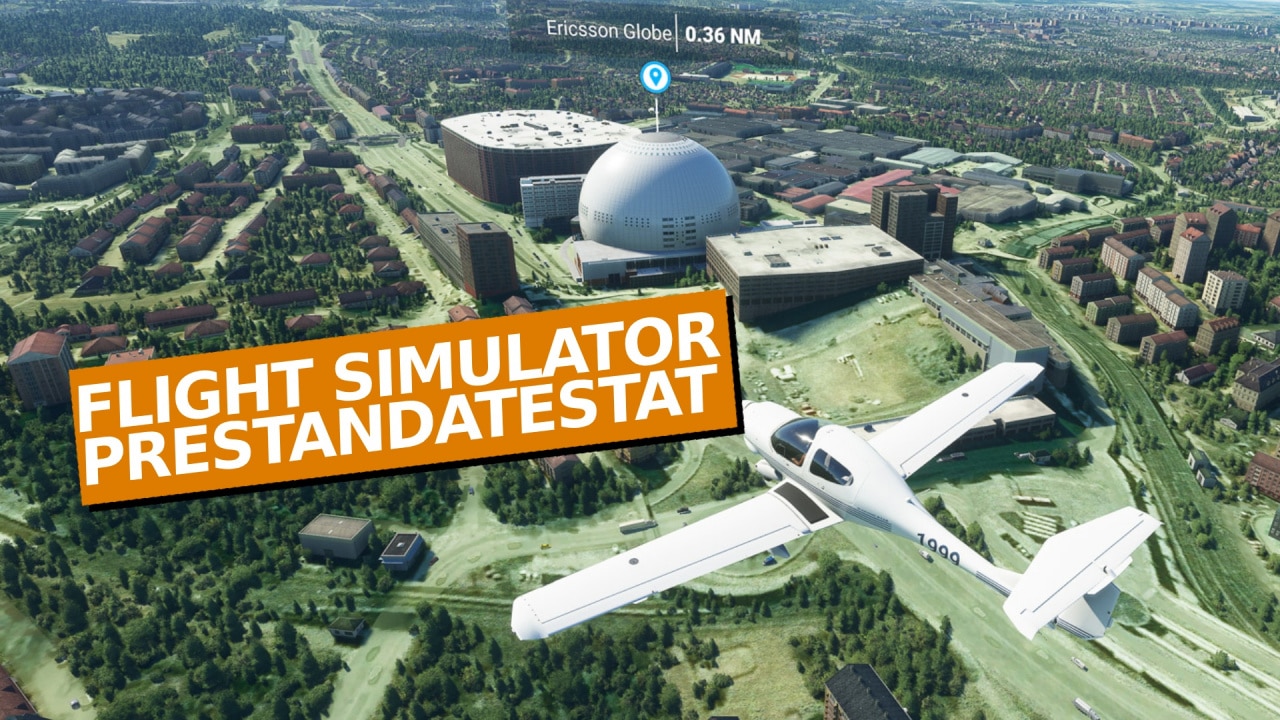After a long wait, aviation enthusiasts can finally explore the world in the new Microsoft Flight Simulator, where the focus is once again on realistic flights in familiar aircraft. The interest in the game title at SweClockers is higher than what the undersigned expected and therefore takes the opportunity to run a quick performance test to see what is required of the graphics card to drive around the title at a comfortable frame rate.
Components of the test system
Component | model | Thanks to |
|---|---|---|
Processor | Intel Core i7-8700K @ 4,7 GHz | Web halls |
Motherboard | ASUS ROG Maximus 10 Hero | Asus |
Memory | 2 × 8 GB G Skill Trident Z RGB | G.Skill |
Graphics card |
| |
Cooling | Noctua NH-D15 | Noctua |
Storage | Samsung 860 Evo, 1 TB | Samsung |
Power supply | Seasonic Prime Ultra Titanium, 1 000 W | Seasonic |
Chassis | Streacom BC1 Open Benchtable | Streacom |
Screen | Dell P2415Q | |
Operating system | Windows 10 Professional 64-bit (2004) | |
As usual, SweClocker’s test rig is used for graphics cards, which houses a Core i7-8700K with an overclocking to 4.7 GHz on all cores. The test loop used is a ride among the French mountains in the propeller plane Robin DR400 / 100 Cadet. The frame rate is measured using the OCAT tool for a period of 55 seconds at resolutions of 1,920 × 1,080, 2,560 × 1,440 and 3,840 × 2,160 pixels while the detail level is set to “High-End”.
First out are the performance figures in the resolution 1,920 × 1,080 pixels where the Geforce RTX 2080 Ti tops the list with 108 FPS, which is not too high compared to the number of pixels. The title is relatively heavy-duty in a higher level of detail where the middle-class graphics card has to struggle to stay above the 60 FPS limit. AMD has a bit of a struggle to keep the same performance form as Nvidia where the Radeon RX 5700 XT ends up just above the Geforce RTX 2060 Super.
With the resolution set at 2,560 × 1,440 pixels, the Radeon RX 5700 XT still pulls evenly with the Geforce RTX 2060 Super, where both end up at 49 FPS and do not provide the desired soft experience that is in demand. The three cards that end up at the top end up above 60 FPS, however, it is literally on the verge of the Geforce RTX 2070 Super.
With a maximum resolution of 3,840 × 2,160 pixels, no card can hold 60 FPS with the level of detail set to High-End. For those who definitely want to play in 4K UHD, it is necessary to thumb a little at the level of detail, alternatively hope for performance optimizations or wait for new graphics cards.
Performance at different levels of detail
Geforce RTX 2080 Ti | 1 920 × 1 080 px | 2 560 × 1 440 px | 3 840 × 2 160 px |
|---|---|---|---|
Low-End | 172/139 | 155/123 | 87/73 |
Medium | 140/87 | 103/78 | 57/47 |
High-end | 108/88 | 80/64 | 45/37 |
Ultra | 79/61 | 59/44 | 35/29 |
Since Microsoft Flight Simulator is quite demanding, it would be interesting to see what performance looks like among other levels of detail, where the Geforce RTX 2080 Ti is the card that can push through all levels. With the controls set at the top, the card can still stay above 60 FPS, but gets tougher the more pixels are thrown into the batter.
On the other hand, there will be significantly more frames with the level of detail set to “Low-End”, but it will also be significantly more boring to watch when the textures almost disappear. For those who are looking for a smooth flow in the game, “High-End” or “Medium” is to recommend and adjust individual details by hand to get the desired result.
Summary thoughts
At the beginning of the performance test, the level of detail “Ultra” was used before the test loop had been nailed, and when the first results came in, it was clear that it is a bit too demanding even for the top cards. Even the “High-End” that the undersigned then decided to test may be too much for some systems out there, especially if a steady frame rate is required no matter where you are in the virtual airspace.
Microsoft Flight Simulator only uses DirectX 11 at present and there are rumors of support for DirectX 12 in the future. Whether this is true and how it will affect performance is currently unclear, but to be able to drive around the game with all the graphic candy activated, a powerful system is required. Fortunately, it is possible to thumb a little at the levels of detail at less critical points that are not as noticeable.
Personally, I prefer to stay on the ground when it comes to simulators, preferably Formula cars with a good steering wheel that allows me to push around the car among the world’s various racing tracks. Flight simulators are therefore a bit unknown ground, something that became very clear when it took a couple of minutes before the plane could take off from the ground.
If you have suitable controls and controls of different types specifically for aircraft, Flight Simulator will probably be very interesting. Above all, it is fun to fly over Stockholm and just see how exactly all houses, roads and landmarks actually correspond to the real world. It is not every day that I park an airplane in my own home.
► Discuss Microsoft Flight Simulator 2020 in the main forum thread
















